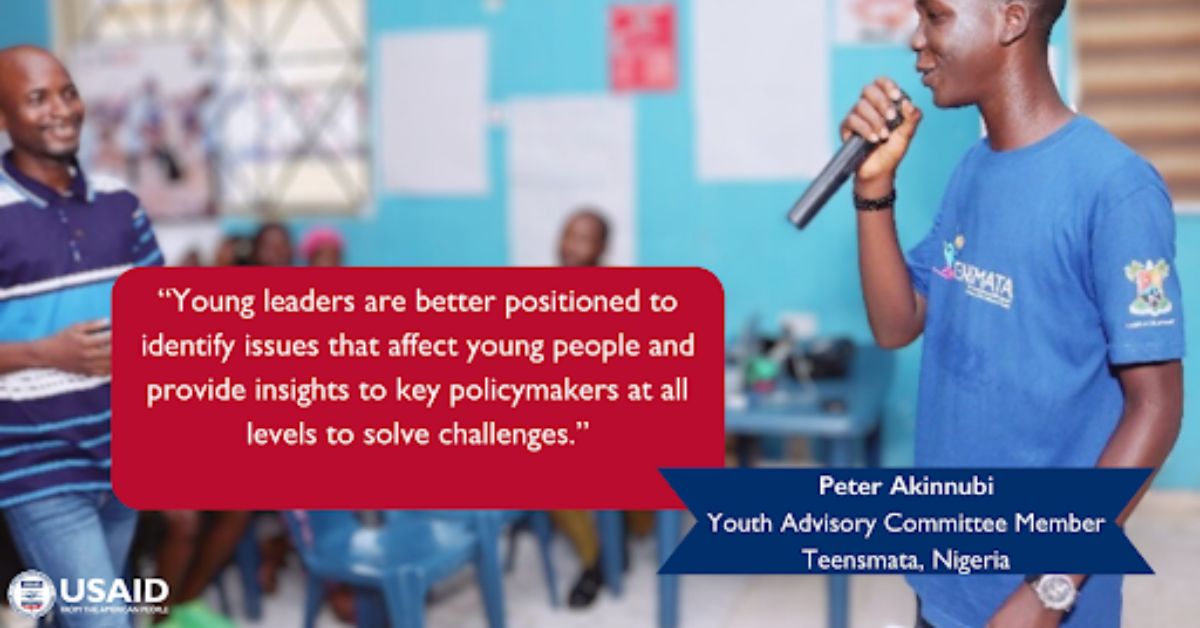Nilofer Siddiqi, USAID
This post was first published on USAID’s LinkedIn.
Today, nearly one third of the global population are youth ages 10-29, the largest youth population in history. That’s 2.4 billion people. Their voices and skills help propel USAID’s development work and create positive change in their communities and around the world. In celebration of the first anniversary of USAID’s updated Youth in Development Policy, which was released last May, we invited youth leaders and USAID leadership to talk about the importance of youth engagement in the health sector.
Evidence shows that if we invest in youth, the current generation will contribute to greater economic growth, democracy, and stability, and development efforts are more efficient and effective when we engage youth as partners.
The overarching goal of the policy is to increase the meaningful participation of youth in all aspects of life—enhancing their skills, providing opportunities for decision-making, and fostering healthy relationships—so they can build on their collective leadership and influence progress in their communities. The policy also recognizes some of the barriers that youth may face due to disability, sexuality, race, ethnicity, gender, and other types of prejudice in tandem with their diverse needs.
During the policy’s launch, USAID Administrator Samantha Power noted, “Young people’s contributions and leadership are critical to every major challenge we face today…It’s time to view young people as the leaders we know them to be.”
Take a look at what’s happened in the first year of this policy.

Innocent Grant, a project director of the Young and Alive Initiative in Tanzania (a youth-led organization supported by USAID’s global project, Youth Excel), said, “Youth leaders understand youth needs at their diversities and their intersections of vulnerabilities. Engagement of youth leaders in USAID programming helps to build responsive programs that uphold human rights, promote accountability and resilience, and provide opportunities for everyone.”

Joseph Kalimbwe, another youth leader, emphasized, “engagement with youth leaders helps USAID to receive first hand information from community leaders on the ground who have direct contact with those affected. From my first time working as a youth advocate in Zambia, I learned how to engage my community and nationally elected officials to create change in the country.” The ability for youth leaders to relay their unique concerns and perspectives to USAID leaders and project implementers such as concerns around stigma when seeking health services and addressing health myths and misinformation in their communities is essential.

“As a USAID DREAMS Ambassador,” says Geraldine Van Schalkwyk, “it is my responsibility to speak for young people like me, build trusting relationships with my peers, and have discussions about what matters most to us when it comes to our health and HIV prevention.”

In her role as a Community Liaison Officer/NextGen Squad Member with USAID’s MOSAIC project in South Africa, Nhlamulo Chantel Manganye advocates to expand access to HIV prevention methods and has trained 150 adolescent girls, young women, and young men to serve as HIV prevention ambassadors. By incorporating youth voices into USAID programming, interventions can more effectively respond to youth needs. This enhances USAID’s ability to work with governments to make health systems more responsive to the needs of young people.
USAID will continue to support new opportunities for youth engagement, including partnering with youth in activity design, supporting implementing partners to hire youth in key leadership roles, incorporating youth feedback and input into adaptive management processes, and supporting youth representation on health facilities and organizational advisory boards.
Atul Gawande, USAID Assistant Administrator for Global Health, says that meaningful youth engagement and leadership will be essential to achieving our global health priorities.
“When we include youth in our health programs and empower them to meaningfully contribute to our work, we create opportunities for leaders of all ages to thrive,” he said. “USAID is committed to supporting the youth health workers, entrepreneurs, designers and innovators who have boundless potential for contributing in creative ways to help us address human resource gaps and apply technology to today’s greatest challenges.”
ABOUT THE AUTHOR: Nilofer Siddiqi is a Program Assistant in the Bureau for Global Health, Office of Population and Reproductive Health. Youth Advisors from the Office of Population and Reproductive Health and the Office of HIV/AIDS also contributed to this story.


